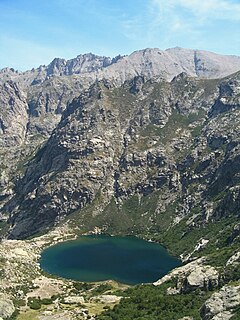Related Research Articles

Mondsee is a lake in the Upper Austrian part of the Salzkammergut and near the larger Attersee. Its southwestern shore marks the border between the states of Upper Austria and Salzburg and also between the Northern Limestone Alps in the south and the Sandstone zone of the northern Alps. The Drachenwand (Dragonwall) at the southern shore of the lake is an impressive sight. Mondsee is one of Austria's last privately owned lakes. In August 2008, owner Nicolette Wächter announced it was up for sale.

The Burkholderiales are an order of Proteobacteria. Like all Proteobacteria, they are Gram-negative. They include several pathogenic bacteria, including species of Burkholderia, Bordetella, and Ralstonia. They also include Oxalobacter and related genera, which are unusual in using oxalic acid as their source of carbon. Other well-studied genera include Alcaligenes, Cupriavidus, Achromobacter, Comamonas, Delftia, Massilia, Duganella, Janthinobacterium, Polynucleobacter, non-pathogenic Paraburkholderia, Caballeronia, Polaromonas, Thiomonas, Collimonas, Hydrogenophaga, Sphaerotilus, Variovorax, Acidovorax, Rubrivivax and Rhodoferax, and Herbaspirillum.

Lac de Melu is a lake in Corsica, France. At an elevation of 1,710 metres (5,610 ft), its surface area is 0.065 square kilometres (0.025 sq mi). The lake is the source of the Restonica River.
Polynucleobacter is a genus of Proteobacteria, originally established by Heckmann and Schmidt (1987) to exclusively harbor obligate endosymbionts of ciliates belonging to the genus Euplotes.
Polynucleobacter necessarius is a bacterium of the genus Polynucleobacter. Since the last revision of the species, it contains exclusively obligate endosymbionts dwelling in cells of the ciliate Euplotes aediculatus and related species. This is in contrast to other species of the genus Polynucleobacter, which exclusively harbour free-living bacteria dwelling in the water column of freshwater systems. The genome of P. necessarius has been completely sequenced.
Polynucleobacter cosmopolitanus is an aerobic, catalase- and oxidase-positive, chemo-organotrophic, nonmotile bacterium of the genus Polynucleobacter, isolated from freshwater habitats in Eurasia, South America, North America, Africa, Oceania, the Hawaiian Archipelago, in lakes located in Japan, and a river estuary of northern Taiwan. The type strain of the species was isolated from Lake Mondsee in Austria.
Polynucleobacter difficilis is an aerobic, catalase- and oxidase-positive, chemo-organotrophic, nonmotile, freshwater bacterium of the genus Polynucleobacter, isolated from the Lake Sevan from a depth of 60 m in Armenia.
Polynucleobacter rarus is an aerobic, chemo-organotrophic, catalase- and oxidase-positive, nonmotile bacterium of the genus Polynucleobacter, isolated from an acidic lake in Wisconsin.
Polynucleobacter asymbioticus is an aerobic, catalase- and oxidase-positive, chemo-organotrophic, nonmotile, free-living bacterium of the genus Polynucleobacter. The type strain was isolated from a small pond located in the Austrian Alps in the area of Salzburg and described as a new subspecies of Polynucleobacter necessarius in 2009. The classification of the type strain was hampered by the fact that its closest described relative represented obligate endosymbionts, i.e. P. necessarius, not available as a pure culture suitable for standard tests for delineation of prokaryotic species. Therefore, the strain was preliminarily placed in the subspecies P. necessarius subsp. asymbioticus. Later sequencing of the genome of the type strain revealed that the strain represented a novel species within the genus Polynucleobacter. Therefore, its taxonomic rank was lifted from the subspecies to the species level. Strains of P. asymbioticus dwell as planktonic organisms in acidic, humic-rich freshwater systems. Comparative genome analyses revealed that P. asymbioticus represents an atypical member of the family Burkholderiaceae regarding its small genome size and its passive lifestyle. A recent study used a collection of 37 P. asymbioticus strains isolated from various ponds located in a larger region of the Austrian Alps to gain insights in the evolution of Polynucleobacter bacteria.
Polynucleobacter duraquae is an aerobic, chemo-organotrophic, catalase- and oxidase-positive, sometimes motile, free-living bacterium of the genus Polynucleobacter, isolated from Lake Mondsee in Austria. The species represents planktonic bacteria (bacterioplankton) dwelling in alkaline freshwater systems.
Polynucleobacter wuianus is an aerobic, chemo-organotrophic, catalase- and oxidase-positive, free-living bacterium of the genus Polynucleobacter, isolated from a small pond located in the Austrian Alps in the area of Salzburg. Bacteria affiliated with this species represent planktonic bacteria (bacterioplankton) dwelling in acidic freshwater systems. The species was named after the Chinese limnologist and microbiologist Qinglong L. Wu who isolated the type strain.
Polynucleobacter sinensis is an aerobic, chemo-organotrophic, catalase- and oxidase-positive, free-living bacterium of the genus Polynucleobacter, isolated from a freshwater pond in China. The species represents planktonic bacteria (bacterioplankton) dwelling in non-acidic freshwater systems. The species name refers to the origin of the type strain from China.
Polynucleobacter yangtzensis is an aerobic, chemo-organotrophic, catalase- and oxidase-positive, sometimes motile, free-living bacterium of the genus Polynucleobacter, isolated from Yangtze River in the City of Nanjing (China). The species represents planktonic bacteria (bacterioplankton) dwelling in alkaline freshwater systems. The species name refers to the origin of the type strain.

Polynucleobacter meluiroseus is an aerobic, chemo-organotrophic, non-motile, free-living bacterium of the genus Polynucleobacter.
Polynucleobacter campilacus is an aerobic, catalase- and oxidase-positive, chemo-organotrophic, nonmotile, free-living bacterium of the genus Polynucleobacter., The type strain was isolated from Lake Feldsee located in the Southern Black Forest in Germany. The species epithet "campilacus" refers to the origin of the type strain from this lake. The complete genome sequence of the strain was determined. Among the described Polynucleobacter species, P. campilacus is closest related to P. hirudinilacicola.
Polynucleobacter victoriensis is an aerobic, chemo-organotrophic, non-motile, free-living bacterium of the genus Polynucleobacter.
Polynucleobacter aenigmaticus is an aerobic, facultatively anaerobic, chemo-organotrophic, non-motile, free-living bacterium of the genus Polynucleobacter.
Polynucleobacter sphagniphilus is an aerobic, chemo-organotrophic, non-motile, free-living bacterium of the genus Polynucleobacter.
Polynucleobacter hirudinilacicola is an aerobic, chemo-organotrophic, non-motile, free-living bacterium of the genus Polynucleobacter.
Polynucleobacter paneuropaeus is an aerobic, facultatively anaerobic, chemo-organotrophic, non-motile, free-living bacterium of the genus Polynucleobacter.
References
- ↑ NamesforLive
- ↑ Straininfo of Polynucleobacter acidiphobus
- ↑ Hahn, MW; Lang, E; Brandt, U; Spröer, C (2011). "Polynucleobacter acidiphobus sp. nov., a representative of an abundant group of planktonic freshwater bacteria". Int J Syst Evol Microbiol. 61 (4): 788–94. doi:10.1099/ijs.0.023929-0. PMC 4266460 . PMID 20435747.
- ↑ UniProt
- ↑ International Journal of Systematic and Evolutionary Microbiology